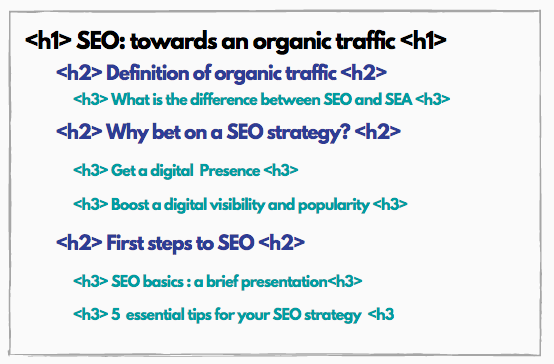Headings tags : how to use them ?
Article recap :
-
Heading tags are markings in the text that define titles and subtitles
-
They are organized in a hierarchy : from H1 to H6, the first being of greater importance than the latter
-
Disrespecting the hierarchical level of the titles compromises the positioning of your content on search engines and goes against good SEO practices.
-
It is recommended only one H1 per page
-
A well structured and well-organized content generates a good experience for the user, and thus, a better ranking
What are heading tags ?
Common in SEO practice, heading tags are markings in the text that define titles and subtitles.They mark points of the prominence of your content in hierarchical levels, that is, they structure the page in a clear and organized way to facilitate indexing and localization by search engines.
Understanding the title tag hierarchy
If in Word the structure is called Title 1 and Title 2, on your website or blog it is called H1 and H2 (being H an abbreviation for heading). It can vary from H1 to H6, the first being of greater importance than the latter. Disrespecting the hierarchical level of the titles compromises the positioning of your content on search engines and goes against good SEO practices. Furthermore, without this ordering, the text may seem confusing making it difficult for the reader to understand. To avoid doubts, let's exemplify :

Notice how headings are organized in order of importance. It is as if one thing is inside the other. When organizing the information, we started talking about the macro theme until we highlighted the specificities, explaining it in detail. Have you ever thought how strange it would be if the divisions were in a different order? It would be a tremendous mess of information and, surely, your reader would not understand anything.
Why are heading tags important for SEO ?
Header tags - or simply headings - are important for Google and other search engines because it helps them to understand the importance of the subject of each page. So it is recommended only one H1 per page. Remembering that a well structured and well-organized content generates a good experience for the user, and thus, a better ranking. Therefore, it is important to follow a summary logic, always leaving as organized as possible your title tags. Here's an example of how to organize your headings, in a SEO blog post for example :

Cocolyze tips :
-
Keep your headings well structured : by organizing your content from the most important information to the least important ones.
-
Try to use keyphrases in them : you can use keyphrases in your headings as a way to “announce” the content.
Do not forget : heading tags are a great way to structure your content and give your users a reason to keep in your page as well as to come back.
